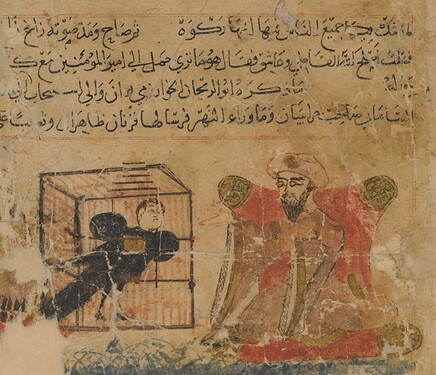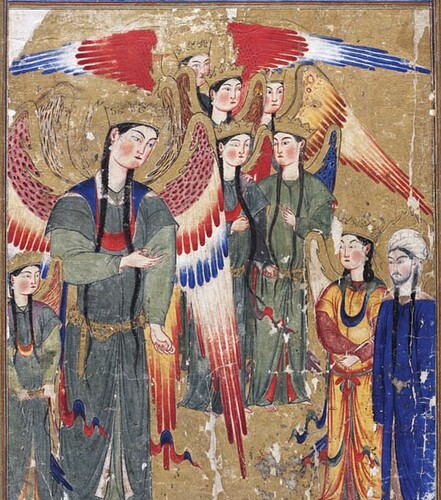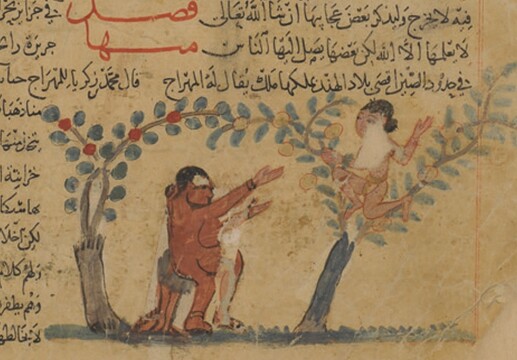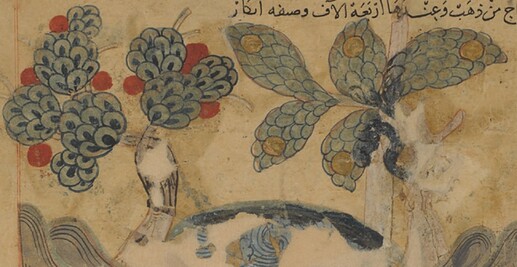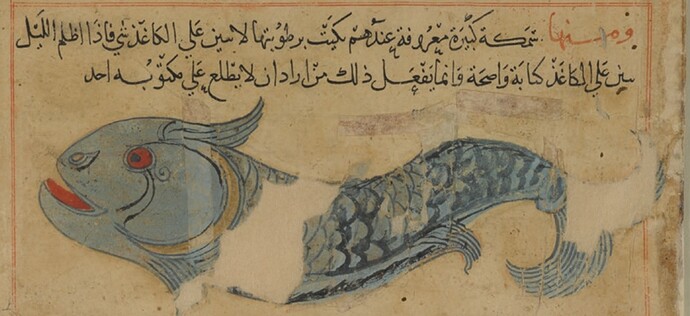Nuryabil, Gatekeeper of the Seventh Heaven and Angel of the Scroll (Book of Ascension)
Nuryabil and his angelic host welcome Jibril (Gabriel) and the Prophet Muhammad as the pair ascend towards the Throne of God.
Then Jibril lifted me up and took me five hundred years’ distance to the seventh heaven. I saw that the substance of the seventh sky was of light. Its breadth was five hundred years’ [distance]. Its name was ‛Arniyā, and the name of its guardian [angel] was Nuryabil. His prayer was this: “Praise be to the Creator of Light, praise be to the most High, praise be to the Exalted and Blessed One, praise be to the Knower of the Unseen, for He does not make anyone acquainted with His secret.”
Angels in Islam are a complicated and shockingly understudied topic (in modern academia that is.) Despite their central importance - disbelief in angels renders one outside the fold of Islam entirely according to essentially every major premodern Muslim book of aqeedah and much of creation, prophecy, revelation etc. can't understood without them - there's a couple reasons why angels haven't gotten much scholarly attention. One difficulty is the "fluidity, instability and diversity of beliefs about angels" within Islam; the Qu'ran and the canonized hadith collections do not present anything even approaching a homogenous dogma of angels, despite what Wikipedia might say! As S. R. Burge puts it: "it is impossible to talk of ‘Islamic angelology’....as there is no systematic ‘theology’
of angels that transcends all individuals or groups within the religion."
There's certainly room (although perhaps not interest  ) for a much larger post on Islamic angelologies - plural! - during the classical and early postclassic periods of theological writing. Today, though, we're looking at one angel in particular.
) for a much larger post on Islamic angelologies - plural! - during the classical and early postclassic periods of theological writing. Today, though, we're looking at one angel in particular.
Nūryābīl is a rather obscure angel, especially considering his (even though angels are often referred to in the masculine, they don't have any gender, it's just convention) lofty position. The Book of Ascension describes the Prophet's meeting with him during the Night Journey, when he traveled on back of the Buraq to Jerusalem and then up into the heavens with Jibril in one night. Nuryabil, distinguished by his great size and resplendent wings, and his crowned helpers greet the Prophet warmly. He teaches the Prophet a prayer to bring back to Earth for his community when his Night Journey is complete and then ushers Muhammad into a realm nearly beyond even the Prophet's ability to comprehend:
I saw angels of light. If they ordered me to describe them, I could never in my whole life describe them because of their size, their splendour, and the beauty of their voices...I saw angels with light coming out of their mouths. Because of the strangeness of their shape and the beauty of their prayers, I almost gave up the ghost. Jibril said to me “Do not be afraid, because tonight God Most High will bring you to a place that nobody has ever reached.” I gained strength from God. I stood up and greeted them.
[Insert Biblically Qur'anically Accurate Angel meme here.]
The painting of Nuryabil in the Book of Ascension, shown in this post, is a remarkable display of the diverse array of influences that combined to form the art of mid-late 1200s Ilkhanate. The wings of the gatekeeper angel are just as striking as the narrative suggests, using Indian birds imported from the Delhi Sultanate as a reference. The golden nimbus that surrounds the head is a borrowing from Byzantine iconography - "halos" are traditionally shown in Islamic art as an aura of fire cloaking the holy figure. Nuryabil and his angels are dressed like Mongol royalty; they wear the jeweled belts and the rich nomad tunics of khagans. The angels' long black hair is plaited in Seljuk fashion, twin braids trailing down on either side. Their crowns are drawn in the style of French art norms from the Crusader States and their faces are patterned on Persianate ideals of androgynous beauty.
The account of the angel Nuryabil, like much of the Ilkhanid Book of Ascension, is drawn from the Kitab al-Mi'raj of the 10th century Nishapuri Sufi scholar Abu al-Qasim al-Qushayri. Al-Qushayri's version of the Seventh Heaven, itself assembled from various Prophetic narrations, calls the gatekeeper angel Nuryayil and is not much more detailed than the Ilkhanid text quoted at the beginning. It contains one particularly interesting element, though, which indirectly adds much to the story; al-Qushayri writes that the angel Nuryalil/Nuryabil is synonymous with the angel Al-Sijill. Although al-Qushayri does not cite any hadith narrations to support this, the resonances between the prayer taught by Nuryabil to the Prophet and al-Sijill's role as well as the placement of al-Sijill in the Seventh Heaven leads me to believe that there's credence to the idea. More importantly, this makes things cooler, so we'll roll with it for this.
Al-Sijill (or The Scroll) is another obscure angel, missing in most angelological texts, but he is mentioned in Imam al-Suyuti's 15th century book of collected narrations on angels called al-Haba'ik fi al-Akhbar al-Mala'ik (or The Arrangement of the Traditions about the Angels.) The first few hadiths recorded on al-Sijill reinterpret the Qu'ranic verse 21:104, shifting the understanding of the verse from a description of a literal divine scroll to a scribal angel named The Scroll.
[244] ‘Abd al-Hamid [on the authority of ‘Atiyya]; he said: al-Sijill is an angel’s name.
[245] Ibn Jarir and Ibn Abi Hatim on the authority of Ibn ‘Umar; he said: Al-Sijill is an angel, when he makes forgiveness ascend, he says: ‘Write it in light!’
[246] Ibn Jarir and Ibn Abi Hatim on the authority of al-Suddi; he said: Al-Sijill is an angel responsible for the books [of Earthly deeds.] When a person dies, he hands over his book to al-Sijill, who shuts it and stores it until the Day of Resurrection.
The last of the narrations on al-Sijill that al-Suyuti cites is the most interesting;
Ibn Abi Hatim and Ibn ‘Asakir on the authority of Abu Ja‘far al-Baqir; he said: al-Sijill is an angel, and Harut and Marut were amongst his helpers. Every day he had [the opportunity] to take three quick looks, during which he would glance at the Umm al-Kitab (or Mother of Books), and have a look. [The book] was not his. [One day] he caught sight of some information in it about the creation of Adam and what was in [the Umm al-Kitab] concerning [Adam]. He secretly told Harut and Marut about it, and when the Most High said: ‘“I am creating on earth a viceroy.” They said, “What, wilt Thou set therein one who will do corruption there.”' [Q. 2:30]; the two of them said: ‘That is disrespectful to the angels.’
Now this is exciting! Firstly, the angel is given the honor of reading from the Mother of Books, also called the Preserved Tablets, in which knowledge of all of the events from the beginning of time to the Day of Judgement are recorded.. He can only look at snippets but even those can provide much information, as his foreknowledge of Adam's creation illustrates. He also is described as the master of the paired angels Harut and Marut, famous as the angels temporarily exiled to Earth (for exactly their objections to humanity's sinful natures, presaged here) and charged with providing humanity the secrets of destructive sorcery as a test for their souls. Finally, although a wholly virtuous creature, there is a bit of subterfuge to his personality when he secretly confers with his subordinates about the introduction of Man. And with all that...
What's Gameable Here?
Quite a bit. The angel Nuryabil, also called al-Sijill, is an immensely powerful divine servitor charged with some of the most important functions in the universe. He watches the entrance into the uppermost Seventh Heaven and receives the book of deeds from each person upon their death for tallying on the Day of Judgement. He is granted a level of access to the Preserved Tablets, allowing him unique glimpses of the Divine Plan. In my opinion, he should built at around 75 Divine Might (placing him on par with figures like the mother goddess Dindyméné in Mythic Locations but decently below more famous major angels like Gabriel/Jibril or Michael/Mika'il.)
Despite this power and importance, I think there's reasons why he might be more prone to interact with magi in your sagas than other angels of comparable power.
-
His snippets of future knowledge could get him entangled in the doings of your players, if they are grand enough. Nuryabil might provide a cryptic warning of future disaster or supernaturally accurate advice to a devout character.
-
He may maintain a particular interest in the lives of magi and other magicians, having been the supervisor and friend of the two angels who first gave humanity the gift of magic. This is likely to be done at a distance, but angels in Islam are far from non-interventionist in the lives of average mortals, and he could always make special note of a given magus or maga in your saga. The attentions of such a potent divine being are bound to cause exciting times, whether or not the character welcomes it.
-
Nuryabil feels rather "human" in some ways, especially for an active angel (no Paradise Lost or Watchers here) of his rank. He earnestly gives the Prophet a prayer to "ease the lives" of people on earth, sneaks peeks at the boss' stuff while on the job, and gossips with his co-workers about odd upcoming events. You can play this up in a game to great effect, as long as his ultimate role as the fierce chief guardian of the Highest Heaven and bearer of grave responsibilities concerning the books of the dead is kept in mind.
